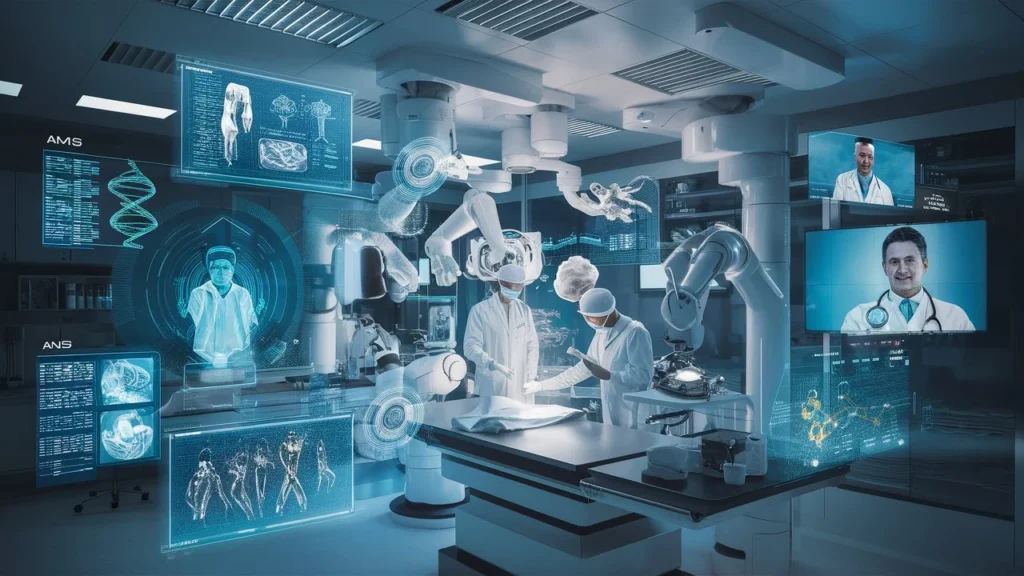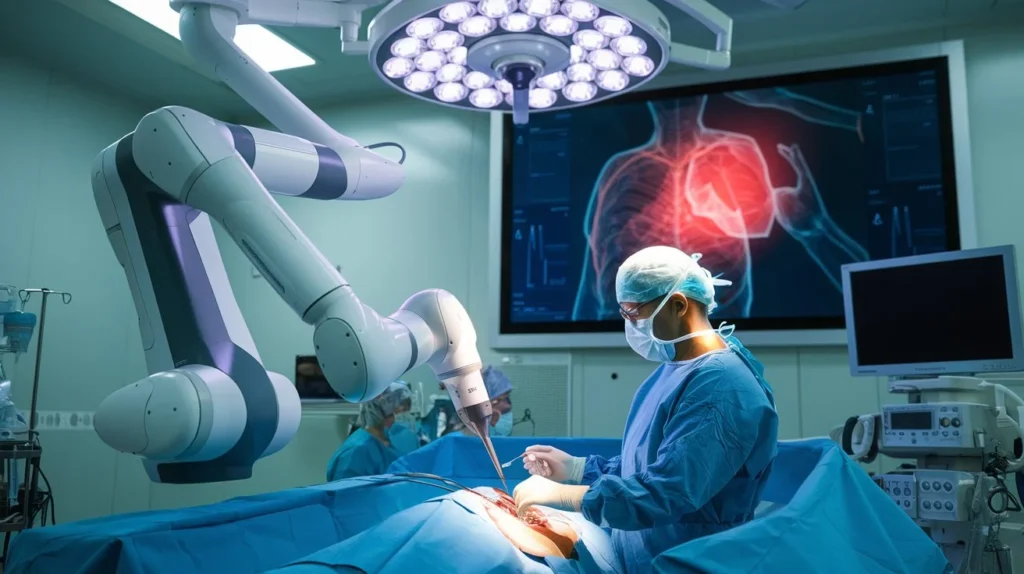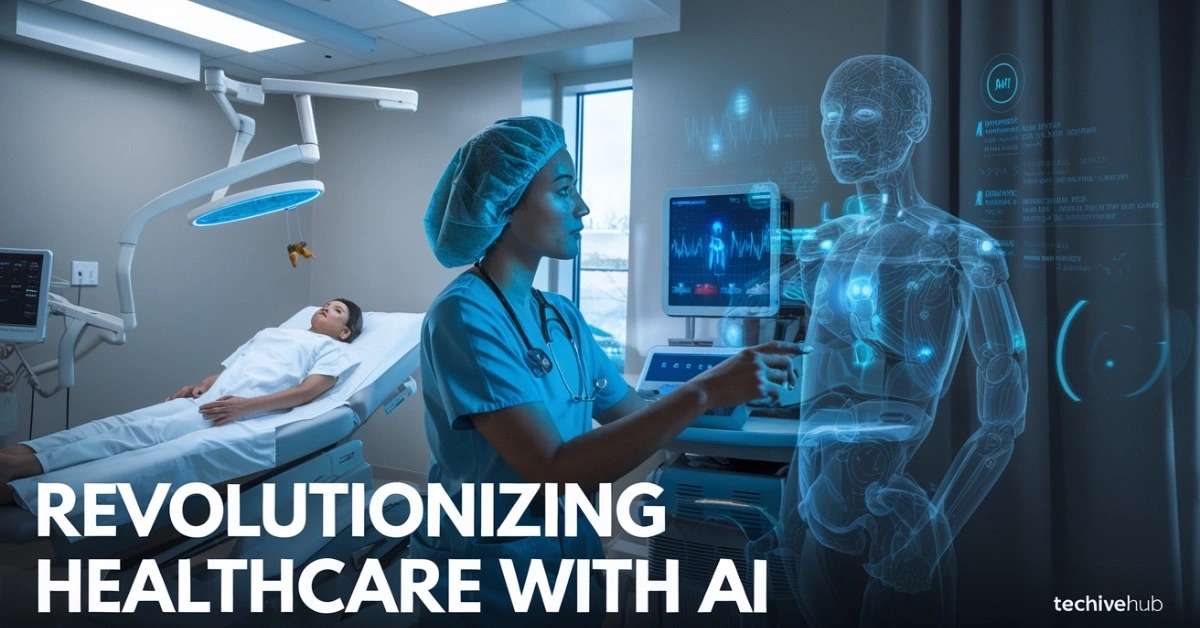Introduction
In the dim light of an empty room, the doctor sits. Her hands are steady, but her eyes carry the weight of years. She reaches for the screen, not a man, but a thing, cold and exact. The machine waits, patient as ever, silent as the long hours of the night. It does not know exhaustion. It does not know fear. It knows data.
Once, the doctor had relied only on what she could see and what she had learned. Now, there is something else. This thing, with no pulse, no hunger, no warmth, sees deeper than she ever could. It does not judge. It reads the lines of numbers and the rivers of blood, and somewhere, in its cold, still core, it understands.
They called it artificial intelligence. But it’s not artificial. It does not pretend to know. It knows because it is built that way—built to understand what human minds cannot always grasp. And in the hospitals and labs, it began to grow. Not in the way of flesh and bone, but in knowledge. Quietly, slowly, like a river cutting through rock, it began to shape medicine.
In the early days, it stumbled. The people in white coats thought it might help, but they didn’t trust it. They tested it, but it wasn’t ready. Decades passed. Then it came back, stronger. Now, it listens when the doctor’s eyes blur from too many charts. It listens when hands tremble in the face of what they do not know.
The world is getting older, the people are more fragile. The doctors are fewer, their work heavier. They need something. Something that doesn’t sleep. They found it in the machines. The machines don’t call themselves heroes. But sometimes, when the doctor lays her head down at last, she knows that the lives saved today were not hers alone.
The road ahead is not clear. Nothing in medicine ever is. But this thing, this cold machine with no soul, carries with it a promise. Not of perfection, but of something close to it. And that, she knows, is enough.
Current Applications of AI in Healthcare

AI in healthcare is not loud. It doesn’t need to be. It’s there, quiet, relentless, reshaping the field with a precision that rivals the human hand and mind. In this world, it’s not about robots walking the halls or machines pushing doctors aside. It’s the unseen force, guiding, calculating, helping, never tiring.
Medical Diagnosis
AI watches. It sees things that even the sharpest human eye might miss. It sifts through symptoms, scans, history, piecing together a story that’s not always obvious. Machines aren’t bound by exhaustion or error—they see all, all the time.
Algorithms, they break down data. Test results. Images. Patterns emerge, patterns that to the human mind are too complex, too subtle. Diseases show themselves early, before they’re ready to make themselves known. In places like New Delhi, AI finds diabetic retinopathy as if it’s been doing this for lifetimes.
Treatment Planning
Once, doctors relied on memory, on experience, on instinct. AI is different. It’s learned from millions of cases. It finds the right path, the right treatment. It knows what’s worked before, what hasn’t. Personalized care is no longer a hope; it’s reality. It predicts complications, sees drug interactions before they happen. In cancer wards, it decides how much radiation is just enough to target the enemy, sparing the body.
Drug Discovery and Development
Finding new drugs was always a gamble—long, slow, expensive. Now, AI runs simulations faster than a chemist could dream. It understands molecular structures, knows how compounds will behave in the body. Thousands of drugs are tested in virtual worlds before a single drop is mixed in a lab. What once took years, now takes months.
Medical Imaging and Radiology
AI sharpens the eyes of radiologists. It turns blurry scans into clear pictures. An X-ray, an MRI—they speak to the machine in ways that humans never could. Urgent cases rise to the top. Time is saved. Lives are saved. The system doesn’t slow, doesn’t falter.
Robotic Surgery

Robots don’t shake. They don’t second guess. AI gives surgeons hands steadier than steel, guiding them, assisting them through cuts so fine they could split a hair. The machine works tirelessly, making surgeries that once seemed impossible into reality. Pre-op, post-op, it’s there. Watching. Calculating.
Administrative Tasks and Workflow Optimization
It’s not just about the surgery, the scans, the diagnosis. AI slips into the quiet corners of healthcare—handling the appointments, answering the routine questions. It manages hospitals like a well-oiled machine. It predicts the flow of patients, balances the books, reduces errors in ways people often overlook.
From Kolkata’s clinics to Bengaluru’s labs, it changes everything, but never in ways that feel foreign. AI isn’t here to replace the human hand or heart. It’s here to lift the burden, to sharpen the tools, to make healthcare what it should be—focused, precise, and always, human.
Benefits of AI in Healthcare
AI in healthcare isn’t a shiny tool. It’s a quiet force, working behind the scenes, where most don’t see. You won’t find the drama in its operations, but in its results. It digs deep, uncovers what’s missed, and lets no detail escape.
Precision in Diagnosis
Think of AI as a watchman. A watchman who never sleeps, never tires. It combs through patient data, x-rays, reports—things we would overlook. Faster than us. Better than us. It knows the patterns before we do.
And in these patterns, it finds what we miss. A spot on the lung, a shadow on a scan. Errors shrink. Twelve million. That’s how many mistakes are made in diagnosis each year in America alone. With AI, that number is not so high.
Enhanced Efficiency in Healthcare Delivery
There’s no fanfare in a well-run machine. No chaos. AI strips away the clutter. It handles the routine, lets doctors be doctors, not clerks. The records, the schedules, the charts, the beds. It’s all handled.
A hospital can breathe when AI manages its resources. The patients flow, and the waiting stops. Far places, remote areas—they feel the change. A consultation happens without a drive. It all happens from a distance, but nothing is distant anymore.
Personalized Medicine
Every patient is different. Yet medicine has tried, too often, to treat them the same. But AI sees them as they are, knows them—down to their genes, their history, their habits. The right drug. The right time. The right treatment.
AI doesn’t just predict what might happen—it knows. How a patient will respond, how a disease will move. It adjusts, it adapts. Always watching, always shifting.
Early Disease Detection and Prevention
You catch a disease early, you beat it. AI in healthcare knows that. It looks at data from the body, from machines we wear, from the records we store. It captures what we don’t feel yet. The cancer not seen, the heart about to fail. It knows who is at risk, and it tells us before it’s too late.
Cost Reduction in Healthcare Systems
AI comes at a cost, yes. But it saves more. It cuts the waste, the errors, the delays. Disease, caught early, doesn’t need expensive care later. The drugs we need—AI finds them faster, cheaper. It’s a long road, but it pays back.
By 2026, they say AI could save $150 billion in U.S. healthcare. Numbers are cold, but what they mean isn’t. Fewer mistakes, faster care, lives saved. It’s not just money; it’s people. Real people.
AI doesn’t boast, it doesn’t shout. It just works. It watches, listens, and learns. And in doing so, it changes the future of healthcare, quietly, piece by piece.
Challenges and Limitations
AI in healthcare carries great promise, but it’s not without its share of shadows. For every breakthrough, there’s a weight to be considered. Let’s walk through those obstacles, clear-eyed.
Data Privacy and Security Concerns
In the world of medicine, data is precious. But that treasure comes with a heavy burden.
AI needs data—lots of it. But the more it’s shared, the more fragile it becomes. A slip here or a breach there, and suddenly the trust is broken. And what then? The patient, once assured of privacy, might lose faith in the system. Laws like India’s DISHA hope to shield this data, but putting those protections into action is easier spoken than done.
Integration with Existing Healthcare Systems
AI doesn’t fit neatly into the current world of healthcare. It demands rewiring, not just in machines, but in minds.
Hospitals, especially in places still catching up with the modern world, lack the backbone for these systems. Doctors, having trusted their hands and eyes for years, can be slow to trust machines with minds of their own. And then there’s the tangled mess of health records. Integrating AI into those systems takes more time than anyone would like to admit.
Regulatory and Ethical Considerations
The pace of AI in healthcare growth outstrips the rules meant to guide it.
If the machine errs, who pays for that mistake? The person who made it, the one who used it, or the machine itself? When lives hang in the balance, how much of the choice should be left to something that doesn’t breathe? There’s a lot to reckon with here, and the answers don’t come quickly.
Potential Job Displacement
The doctor isn’t being replaced—but the job might be. AI can sift through data faster, make sense of numbers, handle admin work in the blink of an eye.
But for the people who have been doing those jobs for years? There’s worry. Change is coming fast, and while AI may create new roles, it’s not always easy to see where you’ll land when the ground starts shifting beneath your feet.
Bias in AI Algorithms
Machines learn from what we give them. And if what we give them is skewed, the machine will be, too.
There’s a story here—a study that found one AI in U.S. hospitals didn’t refer black patients to special care programs as often as white patients with the same problems. This isn’t just a small hiccup. It’s a reminder that the machine reflects us, our faults, our histories, our biases.
These hurdles aren’t walls that can’t be climbed. But it’ll take more than just bright minds working in silos. It’ll take technologists, doctors, lawmakers, and ethicists all sitting at the same table, wrestling with the same questions. The path forward is there, but it’s rough. And as we often say, every challenge carries the seed of its own answer—if you’re willing to dig deep enough to find it.
Future Prospects of AI in Healthcare
The future comes quietly, like a whisper carried by the wind. And if you listen closely, you can hear the hum of machines, not just in factories or on streets, but in our hospitals and homes. The machines, they tell us things now, things we’ve only dreamed of knowing before.
Advancements in Predictive Analytics
Look ahead. There’s a shift coming. One where we know before it happens—when illness knocks before it sets foot inside. We’ll see the patterns. With each pulse, each breath, each quiet change, we’ll know. The numbers and codes will speak, giving warning of a storm before the first clouds appear. And when they do, it’ll be too late for the storm. We will be ready.
AI-powered Wearable Devices and Remote Monitoring
The tools we need aren’t far away. They’re already here, on our wrists, in our pockets. They watch while we sleep, listen while we move. Each heartbeat, each step, each shallow breath—they see more than we can. And when the time comes, they’ll speak to us in ways we understand, and in ways we don’t need to. Hospitals, once so far away, will be closer than ever. Because we’ll carry them with us, stitched into the fabric of our lives.
Virtual Health Assistants and Chatbots
There will be voices, too. Quiet ones, from screens or devices, guiding us through our pains, answering our questions before we even know we have them. In places where a doctor’s touch is a thousand miles away, these voices will be the hands that heal. They will learn to know us, like old friends, patient and wise.
Precision Medicine and Genomics
It goes deeper still. Into our bones. Into the blood that flows through us. Machines will peer into the heart of us, into the very thread of our being. They’ll see the things that make us who we are, and the things that could unmake us. And they will choose a path for us, one that fits like a second skin, one that we alone can walk.
AI in Global Health and Epidemic Management
When the world grows sick again—and it will—the machines will watch over us. They’ll see the sickness before it spreads its shadow. They’ll speak to each other, faster than we ever could, and move the pieces into place, readying the defenses. In dark times, when it feels like the end, they’ll bring hope back, faster than any hand-made cure could.
In quiet corners of the world, where the earth cracks under the sun’s heat and the people live miles from what we call modern, this change will matter the most. There, in the spaces between the noise of the cities, the machines will be the voice of a future that seems too far away. But it’s not far. It’s here now. We just need to listen.
Case Studies
In a city pulsing with life and possibility, there’s a quiet revolution happening in the shadow of skyscrapers. Bengaluru, the tech heart of India, carries within it an innovation that could save countless lives.
Success Story 1: AI in Cancer Detection
A startup, Niramai, has found a new way to fight an old enemy: breast cancer. The tool they’ve crafted is simple, yet profound. It’s called Thermalytix, and it listens to the body in ways human eyes cannot. With a high-resolution thermal device and a mind built in the cloud, it sees the heat within—cancer, in its early whispers.
No needles. No radiation. It works for everyone, especially the young, those for whom mammograms do not speak as clearly. The machine reads the thermal images, the AI translates them into a score, a warning perhaps. In trials, it stands shoulder to shoulder with traditional methods, but without the barriers—cheaper, mobile, gentle.
For India, where the disease often waits too long in the shadows, this tool could bring it into the light sooner. Niramai isn’t just a story about technology. It’s a story about the right tool, in the right place, for the right people.
And then, we shift from this small lab to the vastness of the world.
Success Story 2: AI-powered Drug Discovery
Across oceans, a different kind of discovery is unfolding. In 2020, a system named AlphaFold cracked a puzzle that’s eluded scientists for decades—the way proteins fold into their intricate shapes. This might seem small, but in the world of drug discovery, it’s the key to so much more.
Proteins are the locks that diseases often hide behind, and if you understand their shape, you can craft the key. AlphaFold can predict these shapes with precision, far faster than before. It’s more than just a step forward. It’s a leap, shrinking the time it takes to find new treatments, making cures for cancer and rare diseases not just possible, but nearer.
This isn’t a story bound by borders. It’s global. And in a field where time matters, this change could mean everything.
These aren’t tales from tomorrow. They’re today. AI is already carving new paths in healthcare, from quiet startups to the labs of giants. And as always, the journey is long, but each small step brings us closer to something larger than any of us could have imagined.
Conclusion
The machines did not come to replace us. They came to show us what we’d missed. A hundred thousand details hidden in a single scan. The pulse of an artery is just a shade offbeat. The slumbering gene that could wake and rage. Machines can do this because they were made to. Tireless. Impartial. With a gaze that never blinks.
But these machines, they do not know mercy. They do not understand hope or suffering or love. That’s not their role. The cold calculations and endless graphs are not what heals. The human touch remains. The steady hand that comforts a patient. The voice that offers assurance in the dark.
The doctor sits in that quiet room, machine at her side, still in charge of the story that unfolds. The road ahead is as uncertain as it’s ever been. New knowledge brings new risks, new questions. But with this unblinking partner, she can go further, see clearer, move faster.
The machine listens, the doctor leads. Together, they write a future where the frailty of flesh and blood is not a death sentence. Not alone, but together, with the machine as a guide, and the human heart as the final judge.

